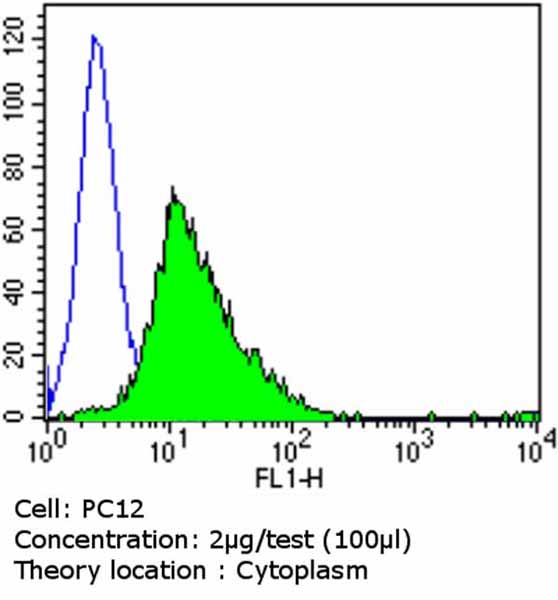
Flow cytometry analysis of Calmodulin showing positive staining in the cytoplasm of PC12 cells compared to an isotype control (blue). Cells were harvested and adjusted to a concentration of 1-5x10^6 cells/ml. Cells were then fixed with 2% paraformaldehyde and washed with PBS. Cells were penetrated by dropping the supernatant and adding 90% methanol followed by incubation for 10 minutes at room temperature. Cells were blocked with a 2% solution of BSA-PBS for 30 min at room temperature and incubated with ab2860 at 2 ug/test for 60 min at room temperature. Cells were then incubated for 40 min at room temperature in the dark using a Dylight 488-conjugated goat anti-mouse IgG (H+L) secondary antibody and re-suspended in PBS for FACS analysis.
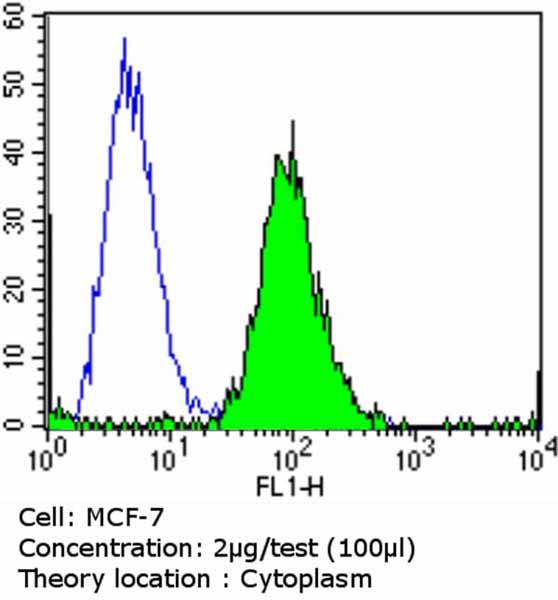
Flow cytometry analysis of Calmodulin showing positive staining in the cytoplasm of MCF-7 cells compared to an isotype control (blue). Cells were harvested and adjusted to a concentration of 1-5x10^6 cells/ml. Cells were then fixed with 2% paraformaldehyde and washed with PBS. Cells were penetrated by dropping the supernatant and adding 90% methanol followed by incubation for 10 minutes at room temperature. Cells were blocked with a 2% solution of BSA-PBS for 30 min at room temperature and incubated with ab2860 at a dilution of 2 ug/test for 60 min at room temperature. Cells were then incubated for 40 min at room temperature in the dark using a Dylight 488-conjugated goat anti-mouse IgG (H+L) secondary antibody and re-suspended in PBS for FACS analysis.
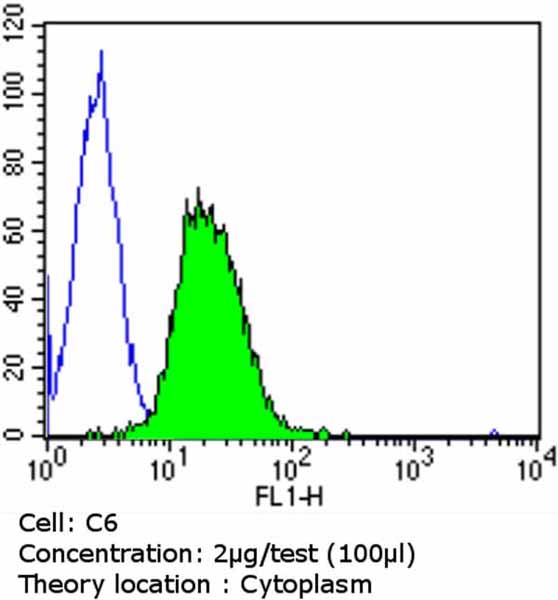
Flow cytometry analysis of Calmodulin showing positive staining in the cytoplasm of C6 cells compared to an isotype control (blue). Cells were harvested and adjusted to a concentration of 1-5x10^6 cells/ml. Cells were then fixed with 2% paraformaldehyde and washed with PBS. Cells were penetrated by dropping the supernatant and adding 90% methanol followed by incubation for 10 minutes at room temperature. Cells were blocked with a 2% solution of BSA-PBS for 30 min at room temperature and incubated with ab2860 at 2 ug/test for 60 min at room temperature. Cells were then incubated for 40 min at room temperature in the dark using a Dylight 488-conjugated goat anti-mouse IgG (H+L) secondary antibody and re-suspended in PBS for FACS analysis.
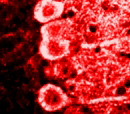
Immunolocalization of calmodulin in rat brain using ab2860 (1:100)
![Anti-Calmodulin antibody [2D1] (ab2860) at 1/500 dilution + Purified Dictyostelium calmodulin](http://www.bioprodhub.com/system/product_images/ab_products/2/sub_1/19517_ab2860_1.jpg)
Anti-Calmodulin antibody [2D1] (ab2860) at 1/500 dilution + Purified Dictyostelium calmodulin
![Overlay histogram showing HeLa cells stained with ab2860 (red line). The cells were fixed with 80% methanol (5 min) and then permeabilized with 0.1% PBS-Tween for 20 min. The cells were then incubated in 1x PBS / 10% normal goat serum / 0.3M glycine to block non-specific protein-protein interactions. The cells were then incubated with the antibody (ab2860, 2µg/1x106 cells) for 30 min at 22ºC. The secondary antibody used was DyLight® 488 goat anti-mouse IgG (H+L) (ab96879) at 1/500 dilution for 30 min at 22ºC. Isotype control antibody (black line) was mouse IgG1 [ICIGG1] (ab91353, 2µg/1x106 cells ) used under the same conditions. Acquisition of >5,000 events was performed.](http://www.bioprodhub.com/system/product_images/ab_products/2/sub_1/19518_Calmodulin-Primary-antibodies-ab2860-6.jpg)
Overlay histogram showing HeLa cells stained with ab2860 (red line). The cells were fixed with 80% methanol (5 min) and then permeabilized with 0.1% PBS-Tween for 20 min. The cells were then incubated in 1x PBS / 10% normal goat serum / 0.3M glycine to block non-specific protein-protein interactions. The cells were then incubated with the antibody (ab2860, 2µg/1x106 cells) for 30 min at 22ºC. The secondary antibody used was DyLight® 488 goat anti-mouse IgG (H+L) (ab96879) at 1/500 dilution for 30 min at 22ºC. Isotype control antibody (black line) was mouse IgG1 [ICIGG1] (ab91353, 2µg/1x106 cells ) used under the same conditions. Acquisition of >5,000 events was performed.
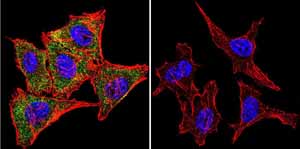
Immunofluorescent analysis of Calmodulin using Calmodulin Monoclonal antibody (2D1) ab2860 shows staining in HeLa cells. Calmodulin staining (green) F-Actin staining with Phalloidin (red) and nuclei with DAPI (blue) is shown. Cells were grown on chamber slides and fixed with formaldehyde prior to staining. Cells were probed without (control) or with or an antibody recognizing Calmodulin ab2860 at a dilution of 1:20 over night at 4 ?C washed with PBS and incubated with a DyLight-488 conjugated secondary antibody. Images were taken at 60X magnification.
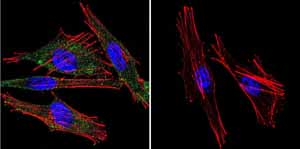
Immunofluorescent analysis of Calmodulin using Calmodulin Monoclonal antibody (2D1) ab2860 shows staining in A2058 melanoma cells. Calmodulin staining (green) F-Actin staining with Phalloidin (red) and nuclei with DAPI (blue) is shown. Cells were grown on chamber slides and fixed with formaldehyde prior to staining. Cells were probed without (control) or with or an antibody recognizing Calmodulin ab2860 at a dilution of 1:20 over night at 4 ?C washed with PBS and incubated with a DyLight-488 conjugated secondary antibody. Images were taken at 60X magnification.
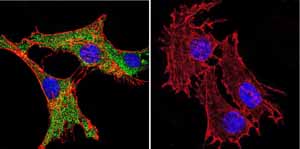
Immunofluorescent analysis of Calmodulin using Calmodulin Monoclonal antibody (2D1) ab2860 shows staining in C6 glioma cells. Calmodulin staining (green) F-Actin staining with Phalloidin (red) and nuclei with DAPI (blue) is shown. Cells were grown on chamber slides and fixed with formaldehyde prior to staining. Cells were probed without (control) or with or an antibody recognizing Calmodulin ab2860 at a dilution of 1:20 over night at 4 ?C washed with PBS and incubated with a DyLight-488 conjugated secondary antibody. Images were taken at 60X magnification.
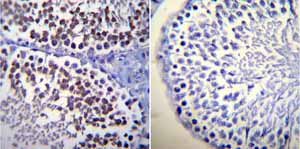
Immunohistochemistry was performed on normal biopsies of deparaffinized Rat testis tissue. To expose target proteins heat induced antigen retrieval was performed using 10mM sodium citrate (pH6.0) buffer microwaved for 8-15 minutes. Following antigen retrieval tissues were blocked in 3% BSA-PBS for 30 minutes at room temperature. Tissues were then probed at a dilution of 1:20 with a mouse monoclonal antibody recognizing Calmodulin ab2860 or without primary antibody (negative control) overnight at 4°C in a humidified chamber. Tissues were washed extensively with PBST and endogenous peroxidase activity was quenched with a peroxidase suppressor. Detection was performed using a biotin-conjugated secondary antibody and SA-HRP followed by colorimetric detection using DAB. Tissues were counterstained with hematoxylin and prepped for mounting.
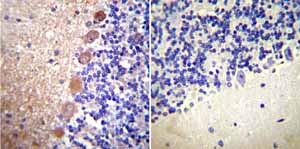
Immunohistochemistry was performed on normal biopsies of deparaffinized Rat cerebellum tissue. To expose target proteins heat induced antigen retrieval was performed using 10mM sodium citrate (pH6.0) buffer microwaved for 8-15 minutes. Following antigen retrieval tissues were blocked in 3% BSA-PBS for 30 minutes at room temperature. Tissues were then probed at a dilution of 1:20 with a mouse monoclonal antibody recognizing Calmodulin ab2860 or without primary antibody (negative control) overnight at 4°C in a humidified chamber. Tissues were washed extensively with PBST and endogenous peroxidase activity was quenched with a peroxidase suppressor. Detection was performed using a biotin-conjugated secondary antibody and SA-HRP followed by colorimetric detection using DAB. Tissues were counterstained with hematoxylin and prepped for mounting.




![Anti-Calmodulin antibody [2D1] (ab2860) at 1/500 dilution + Purified Dictyostelium calmodulin](http://www.bioprodhub.com/system/product_images/ab_products/2/sub_1/19517_ab2860_1.jpg)
![Overlay histogram showing HeLa cells stained with ab2860 (red line). The cells were fixed with 80% methanol (5 min) and then permeabilized with 0.1% PBS-Tween for 20 min. The cells were then incubated in 1x PBS / 10% normal goat serum / 0.3M glycine to block non-specific protein-protein interactions. The cells were then incubated with the antibody (ab2860, 2µg/1x106 cells) for 30 min at 22ºC. The secondary antibody used was DyLight® 488 goat anti-mouse IgG (H+L) (ab96879) at 1/500 dilution for 30 min at 22ºC. Isotype control antibody (black line) was mouse IgG1 [ICIGG1] (ab91353, 2µg/1x106 cells ) used under the same conditions. Acquisition of >5,000 events was performed.](http://www.bioprodhub.com/system/product_images/ab_products/2/sub_1/19518_Calmodulin-Primary-antibodies-ab2860-6.jpg)




